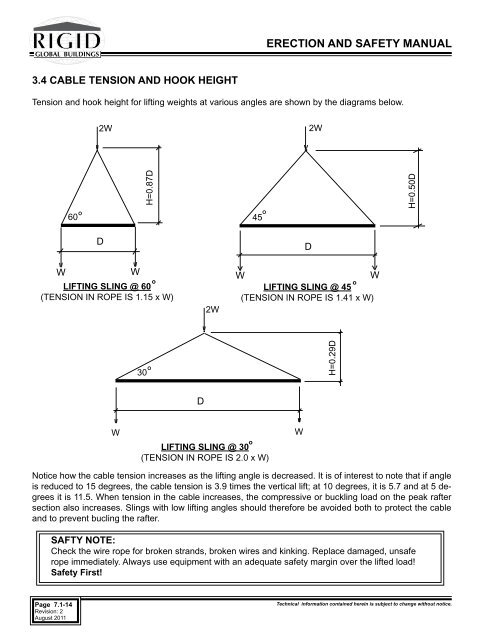ERECTION AND SAFETY MANUAL - Rigid Global Buildings
ERECTION AND SAFETY MANUAL - Rigid Global Buildings
ERECTION AND SAFETY MANUAL - Rigid Global Buildings
Create successful ePaper yourself
Turn your PDF publications into a flip-book with our unique Google optimized e-Paper software.
3.4 CABLE TENSION <strong>AND</strong> HOOK HEIGHT<br />
Page 7.1-14<br />
Revision: 2<br />
August 2011<br />
<strong>ERECTION</strong> <strong>AND</strong> <strong>SAFETY</strong> <strong>MANUAL</strong><br />
Tension and hook height for lifting weights at various angles are shown by the diagrams below.<br />
60 O<br />
2W<br />
D<br />
W W<br />
H=0.87D<br />
LIFTING SLING @ 60<br />
(TENSION IN ROPE IS 1.15 x W)<br />
W<br />
30 O<br />
o<br />
D<br />
2W<br />
45 O<br />
o<br />
LIFTING SLING @ 30<br />
(TENSION IN ROPE IS 2.0 x W)<br />
D<br />
2W<br />
W<br />
o<br />
LIFTING SLING @ 45<br />
W<br />
(TENSION IN ROPE IS 1.41 x W)<br />
Notice how the cable tension increases as the lifting angle is decreased. It is of interest to note that if angle<br />
is reduced to 15 degrees, the cable tension is 3.9 times the vertical lift; at 10 degrees, it is 5.7 and at 5 degrees<br />
it is 11.5. When tension in the cable increases, the compressive or buckling load on the peak rafter<br />
section also increases. Slings with low lifting angles should therefore be avoided both to protect the cable<br />
and to prevent bucling the rafter.<br />
SAFTY NOTE:<br />
Check the wire rope for broken strands, broken wires and kinking. Replace damaged, unsafe<br />
rope immediately. Always use equipment with an adequate safety margin over the lifted load!<br />
Safety First!<br />
W<br />
H=0.29D<br />
H=0.50D<br />
Technical information contained herein is subject to change without notice.


